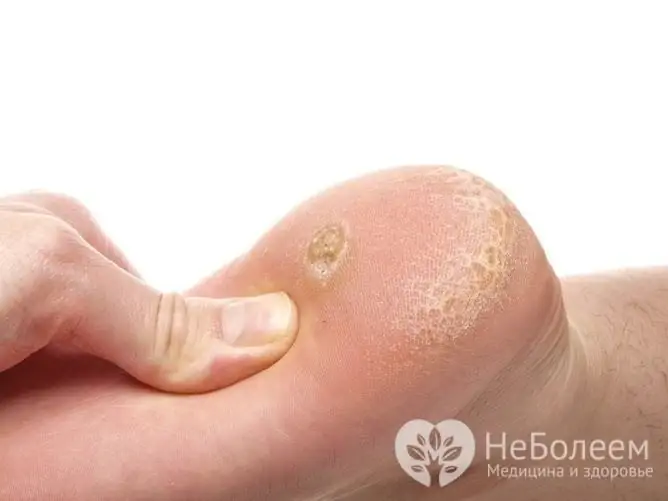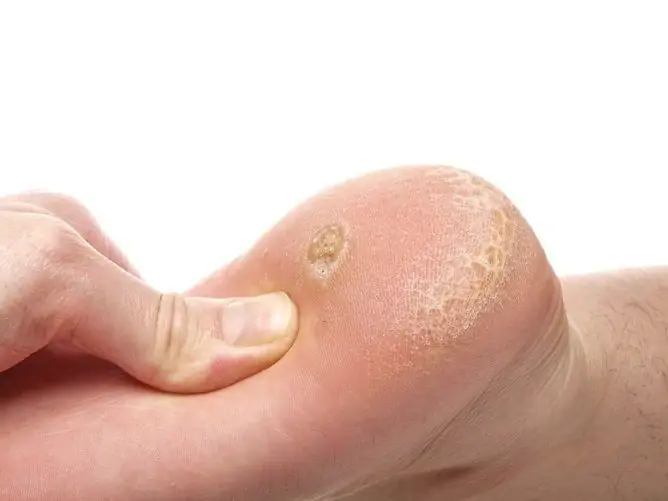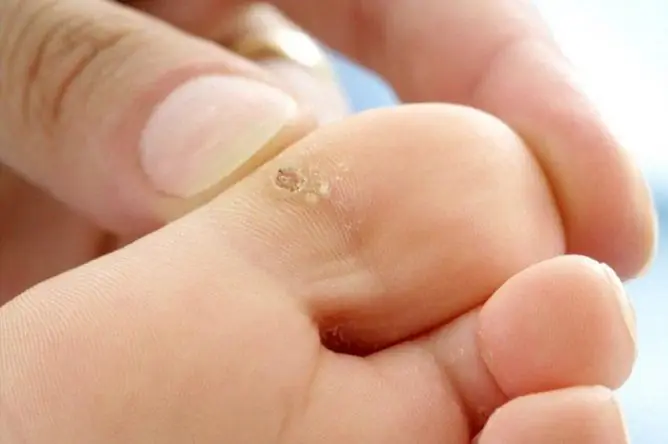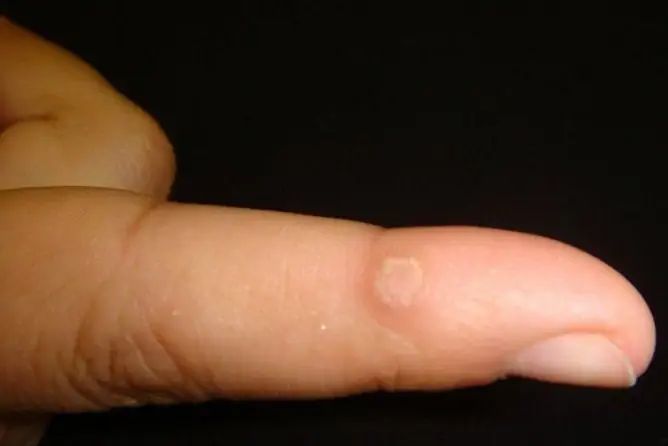- Author Rachel Wainwright [email protected].
- Public 2024-01-15 19:51.
- Last modified 2025-11-02 20:14.
Wart on the heel
The content of the article:
- Features of the disease
- The reasons
- External signs of plantar warts
- Traditional methods of treatment
- Video
Heel warts are benign skin neoplasms of an infectious nature. The reason for the appearance is the DNA-containing dermatotropic human papillomavirus (HPV).

Heel warts can occur in patients of any age
Features of the disease
- They occur in a person, as a rule, at a young age (often even in a child). There is no correlation dependence on gender.
- It is necessary to treat the skin growth with conservative methods for a long time, but even after its disappearance, the risk of recurrence remains high.
- In connection with the contact and household transmission, it is an extremely common infectious disease.
The reasons
The development of a wart is caused by the human papillomavirus. HPV has a tendency to persist for a long time in the body, with a sufficient immune response, asymptomatic carriage takes place. The approximate time of the incubation period, taking into account the possible carriage, is from several weeks to 9 months, the clinical symptoms of the disease appear during the period of decreased immunity.
Taxonomically, HPV is divided into childbirth, depending on the tropism for different types of epithelium and different areas of the skin on the body:
- alpha - affect the anogenital region (the most dangerous of them are oncogenic strains 16, 18, 31, 35, 39, 58);
- beta - affect the keratinizing epithelium of the skin of the trunk, face;
- gamma - also has a tropism for the keratinizing epithelium, but to a greater extent they affect the limbs (strains for plantar warts - 1, 2, 4).
Features of HPV:
- contains DNA;
- affects the basal (germ) layer of the epidermis;
- distributed by contact;
- some of its strains have a high carcinogenic risk, and therefore infection with them belongs to precancerous conditions (with regard to plantar warts, the oncological risk is minimal).
The following predisposing factors exist:
- Immune system disorders. HPV affects people with a weakened immune response. Frequent viral or bacterial diseases also lead to the depletion of this system and disruption of its normal operation.
- Violation of the lifestyle (poor diet, lack of physical activity). This leads to a violation of metabolic and metabolic processes in the body, which makes it difficult to suppress the pathogen.
- Chronic overwork and stress have an indirect effect on the functioning of the immune and a number of other systems (endocrine, for example). This leads to exhaustion of the body and the impossibility of an adequate immune response.
- Traumatic damage to the skin (microtrauma and abrasions received in the pool, for example) can lead to infection and infection. But this factor is realized only in combination with a weakened immune system.
External signs of plantar warts
The appearance of warts may vary slightly depending on the specific shape. The main types that are localized on the skin of the feet (including the heels) are presented in the table.
| The form | External features |
| Simple |
They are localized on the dorsum of the feet (occasionally they can occur in the area of the heels), have a small size (up to 0.5-0.7 cm) and an uneven surface (covered with horny epithelium), the color varies from pale pink to yellow-gray. They have a long course and a positive response to treatment. |
| Plantar | Localized in areas exposed to maximum pressure (most often occurs in the heels), outwardly resemble a yellowish corn up to 1 cm in size (see photo). In the center is the hypertrophied tissue of the epidermis, which bleeds easily, can be painful when walking. |
| Cystic | They arise on the pressing surface of the foot. They have a cavity, when opened, a whitish curdled mass is released. As a rule, they are single with an uneven surface and a small diameter (up to 1 cm). |
There are other types of warts (flat, filiform, etc.), but they are extremely rare in the area of the feet.
Traditional methods of treatment
At home, treatment of a wart on the heel is possible, but it must be borne in mind that you will need:
- Regular and long-term course of therapy (if necessary, several courses at intervals of 7-10 days).
- A combination of external and internal treatments for heel warts (oral agents help to strengthen the immune system and thereby eliminate the root cause).
- Preliminary consultation with a specialist and establishment of an accurate diagnosis. Self-medication is highly undesirable, since if a tumor formation can be mistaken for a wart. The treatment of skin cancers with the help of products intended for warts can lead to a significant aggravation of the problem.
Methods for removing a heel wart using folk remedies are presented in the table.
| Means | Recipes |
| Celandine |
1. Break off the fresh stem of the plant and squeeze out the juice. The released juice lubricate the affected area 3-5 times a day. The course is 14 days. 2. Take 2-3 tsp. dry celandine and mix with 200 ml of ethyl alcohol. Insist for 2 weeks and then apply as a compress to the affected area. 3. Pour 200-300 ml of water over 2-4 crushed plant stems and bring to a boil. After complete cooling, use the decoction to wipe the warts 2-4 times a day. |
| Garlic |
1. Grind a clove of garlic and apply the resulting gruel to the wart for 10-15 minutes. Repeat the procedure for 7-14 days. 2. Pour 100-150 ml of wine vinegar over 3 cloves of garlic. Insist for 14 days and use as a compress on warts (10-20 minutes 2-3 times a day). 3. Lubricate the warts with freshly squeezed garlic juice 2-3 times a day for 8-10 days. |
| Potatoes |
1. Wipe the affected area with a cut potato 4-5 times a day. 2. Grind 1 fresh potato to a mushy mass. Strain it through cheesecloth and lubricate the wart with the resulting juice 3-5 times a day. |
| Onion |
1. Grind 1 fresh onion to a state of gruel. Apply to the affected area in the form of a compress for 10-20 minutes 2-4 times a day. 2. Lubricate warts with bulbous juice 5-6 times a day for 10 days. |
| Calendula |
1. Grind 2-3 calendula flowers and apply the mixture to the heel. Secure with a plaster and keep for 2-3 hours. 2. Mix in equal proportions (2 tsp) calendula, mint and lemon balm. Pour 200 ml of water and bring to a boil. Apply lotions 2-3 times a day for 14 days. |
| Aloe |
1. Grind 1-2 plant stems to the state of gruel and make compresses from it 2-3 times a day. The duration of the course is 14 days. 2. Pour 200 ml of vodka on 2-3 crushed plant stems. Insist for 14 days. To make compresses from the resulting insist 2-3 times a day. |
| Sagebrush | Pour 4 tbsp. l. wormwood 100 ml of boiling water and soak for an hour. With the resulting product, wipe the warts or apply lotions 2 times a day. |
Mixtures of medicinal herbs (chamomile, thyme, mint, dandelion) are used as drugs taken orally.

Herbal preparations are taken orally to strengthen the immune system
Herbal teas can be used as tea, and can also be used to make alcohol tinctures. Recipes:
- Mix 2 tsp. chamomile, 1 tsp. tarragon, 1 tsp. sage. Pour 200 ml of water and bring to a boil. Simmer for 20 minutes, cool and use as a classic tea.
- Mix 3 tsp. white acacia flowers, 2 tsp. marshmallow and 1 tsp. egg capsules yellow. Pour the mixture with 100 ml of vodka and leave for 14 days. Use as compresses and lotions.
In cases of individual intolerance or a number of concomitant diseases, the use of folk remedies requires caution. Traditional methods of treatment are not an alternative to traditional therapy (ointments, pills or surgical removal), but complement it. If the wart formation cannot be removed on its own, you should consult a doctor and remove it using medical means.
Video
We offer for viewing a video on the topic of the article.

Anna Kozlova Medical journalist About the author
Education: Rostov State Medical University, specialty "General Medicine".
Found a mistake in the text? Select it and press Ctrl + Enter.






